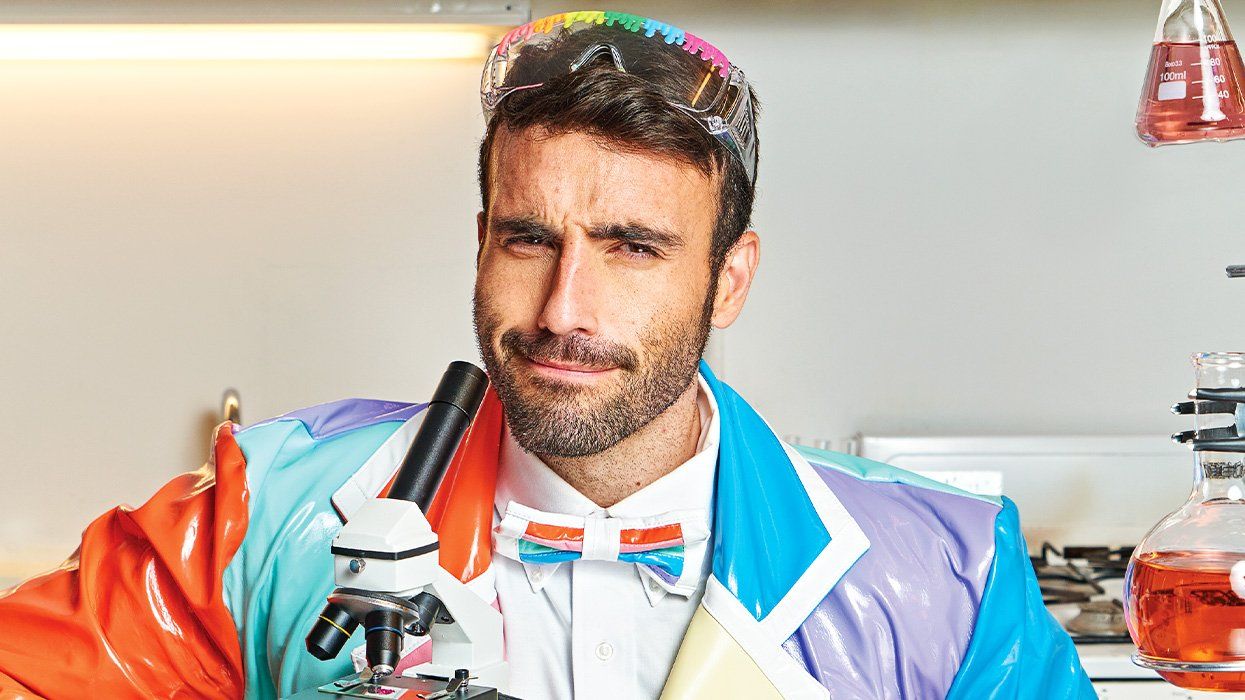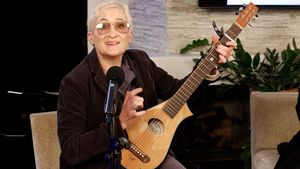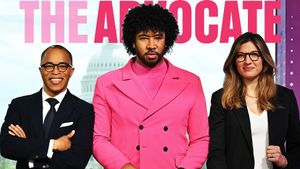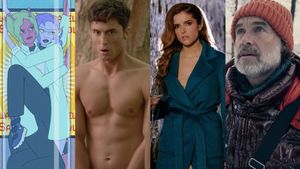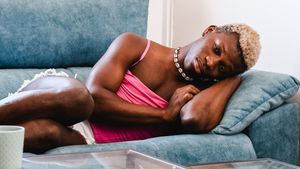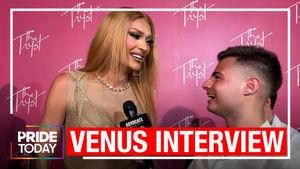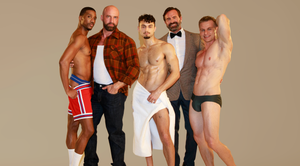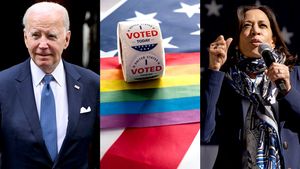Rob Anderson is a comedian and influencer known for hilarious recaps of nostalgic millennial content, from Berenstain Bears books to Seventh Heaven episodes to The Neverending Story.
One of his most popular series, however, isGay Science, in which Anderson applies the scientific method to gay stereotypes. For example, why do gay men like iced coffee? Partly, so they can walk faster to events they’re already late for. (Their bodies also run hotter from processing both real-life and TV drama.)
Anderson has now brought his Gay Scientific Method to the publishing world with a new satirical textbook, Gay Science: The Totally Scientific Examination of LGBTQ+ Culture, Myths, and Stereotypes. In it, no trope is safe from pie charts and pictographs — and sometimes, there’s a test tube of truth amid the hilarity. Hear more from Anderson ahead.
What was the inspiration behind Gay Science?
I was amused by gay stereotypes and how our community embraces them. So, using my own version of “science,” I made a short video explaining why gays prefer iced coffee over hot coffee. The absurdity of it all paired with a matter-of-fact tone struck a positive chord with the community. I have now made over 50 episodes, explaining everything from bisexual panic to guncles to same-sex parenting.
What opportunities did creating the book offer that are unique to a print format?
The satirical nature of the material really hits you in the face with [the] textbook book format. I had a lot of fun with the informative sidebars, experiments to try at home, and stock images. Because the videos are edited at a fast pace, it’s quite easy to miss some of the references. In a book format, the reader can explore the humor at their own pace. This gave me an opportunity to create charts and graphs that I couldn’t make in the video series.
Tell us how you became an influencer.
My comedy career sort of happened when I wasn’t really trying to have one! I spent almost a decade performing for well-known improv theaters in Chicago and left that behind to work in marketing and social media in NYC. I got into TikTok for work when the app became popular in late 2019, which inspired me to start posting my own [videos]. My very first video went viral — a parody of that video where a woman is singing [“Shallow” from] A Star Is Born in the subway. I got signed by [the entertainment agency] UTA and quit my job within a few months. It’s been incredible to work for myself, and I’m very grateful, especially to the queer community for supporting me and sharing my content.
The book is in many ways a collection of gay stereotypes — but some might also call that anthropology! How did you go about navigating that line between funny and offensive?
The book pokes fun at queer behavior without making queer people the punchline. We can laugh at ourselves while still feeling good about who we are. Being closeted isn’t a weakness, but instead a defensive strategy. The “gay run” looks awkward but there’s a biological reason for it. We’re the evolved ones here! Within this humor, there’s some serious topics being addressed. For example, the “gay isolation” required at vacation spots is due to protection from societal stigma. Or there’s the reality of higher rates of drug and alcohol consumption among queer people.

Do you see your comedy as holding up a mirror to oppression or, perhaps, self-destructive behavior?
Definitely. Behind the science humor, there are attempts to tie real causes to the behaviors and stereotypes, without placing judgment or shame on our community. In the end, it’s entertainment and not a therapy session — but for some people, it can be both!
What personal experiences helped make you a comedic authority on LGBTQ+ culture?
I do tap into my experience as a gay man for some gay material. However, we’re all individuals with very different lives, so to claim to represent all the people inside a community, or even a letter within the community, is preposterous (something our online community doesn’t seem to understand yet when it comes to queer representation in movies and TV shows). I am an active listener in queer spaces and use that discourse to make my own commentary and jokes. I do a lot of research before making a joke that’s about a part of the community I don’t personally belong to — and those jokes are usually at the expense of the oppressors.
Any research methods you’d like to share?
The Gay Scientific Method (using your own personal experiences as irrefutable facts) is a well-placed introduction to a book that’s about to make grand, generalized statements about a large group of people. I absolutely used this method writing the book, but I also spent a lot of time in queer forums, feeds, and threads to understand how much self-depreciation each part of the community enjoys.
How did your own school-age experiences inform your understanding of queer culture?
When I was a young teenager with a dial-up internet, I downloaded Bel Ami porn from [file-sharing apps] like Kazaa and LimeWire. For me, queer culture was exclusively hairless men from Bratislava. Later on in high school, I binged the U.S. Queer as Folk on DVD, which informed me on everything else. Both were highly formative!
Interestingly, Gay Science begins with a message to potential book banners as well as a separate reminder that the work is indeed satire. That is a lot of disclaimers. What reservations did you have in releasing a book like this in a volatile political climate of conservative censorship?
I don’t think the book would have needed either of those disclaimers about a decade ago, but we’re in a new, strange era of attack from conservative politicians and billionaire fantasy writers. To be clear, I could care less about ignorant people who lack critical-thinking skills. The first message is meant to make fun of these people, rather than actually warn them about the content. The second disclaimer is meant for members of the queer community. Every now and then, a gay person misses the joke and takes Gay Science seriously, claiming it perpetuates the stereotypes that it’s criticizing. I also think that’s their problem, but my publisher, who makes real educational books, heavily suggested a warning for them. I obliged!
The book’s look is adorable. It’s so nostalgic of actual student textbooks, from the “issued to” stamp on the front inside cover to the various graphs illustrating, say, the composition of emotionally unavailable men in the gay dating pool. Tell us a little about the design process.
Thank you! I really wanted it to feel like a familiar textbook, so I purchased almost a dozen old science books from eBay and took different bits and pieces that I liked from each. I was so specific about the look and design that my editor wanted to murder me by the end of it all. There were times where I thought the illustrations looked too modern, so I scrapped about half of them and redesigned them myself to look more educational. Even the stock images had to have a specific quality to them. They couldn’t be too presentational and needed to look boring for the comedic captions to work. I eventually swapped all of them out at least once too. Like I said, I really put my editor through it!
Which is your favorite graph?
There’s a Venn diagram in the chapter “What does it mean to be intersex” that I quite like. The chapter illustrates [society’s] weird obsession around the genitals of newborns and how that affects intersex people, who often have theirs permanently removed after birth without their consent. This practice is still common and accepted, so I made a diagram showing how truly weird that is.
Any Gay Science pearls of wisdom you’d like to offer Out readers as they navigate Pride season?
I understand why people are conflicted about rainbow capitalism, but it doesn’t have to be so complicated. Always take their money, but don’t give them any. If a massive corporation is going to donate to a queer cause, support a queer artist, sponsor a drag queen’s tour, or give resources to our community — don’t shame that queer group or person for taking that check. Someone is getting that money, it might as well be them! But that big retail rainbow merch — you’re probably better off supporting a queer small business.
Gay Science is available at major and many independent bookstores. Find it at Bookshop.org or Allstora.com, which splits profits with authors to support writers like Anderson. Follow him on Instagram @heartthrobanderson and TikTok @heartthrobert.
This article is part of Out's July/August issue, which hits newsstands on July 2. Support queer media and subscribe— or download the issue through Apple News, Zinio, Nook, or PressReader starting June 18.
